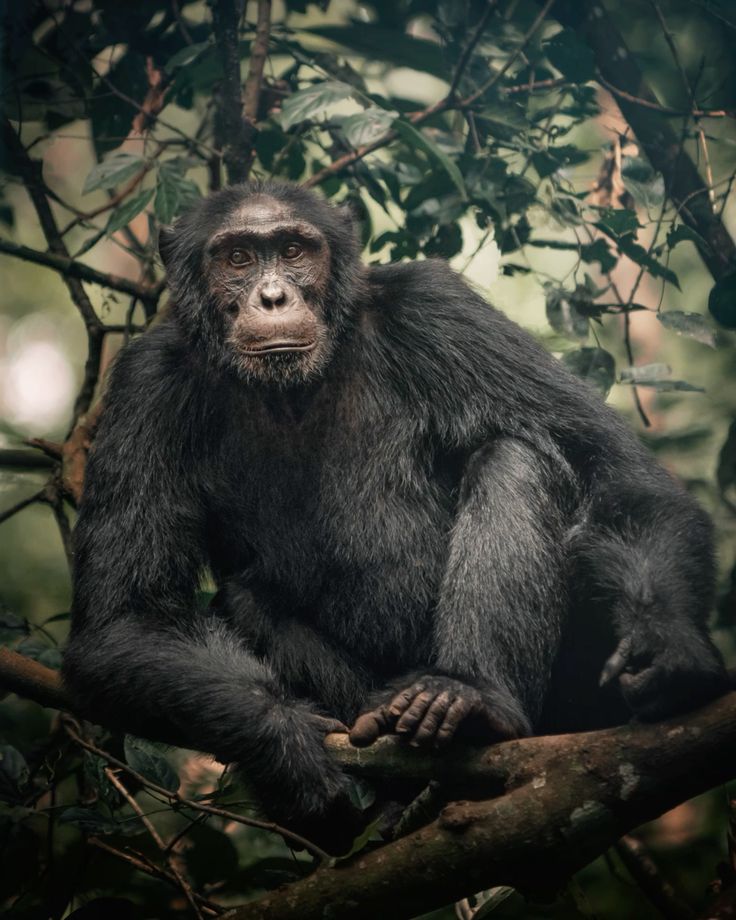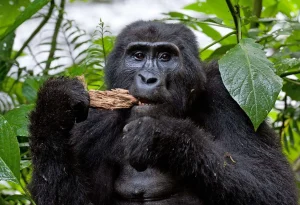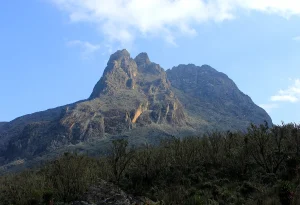Chimpanzee habituation in Kibale National Park
Apart from the high chances of spotting chimps, Kibale National Park is special because visitors are offered the opportunity. This activity is different from standard chimpanzee tracking because it involves spending a whole day with the chimps. The experience is special because you learn more and contribute to the chimpanzee habituation process under the guidance and attention of researchers and experienced trackers.
What is the Cost of chimpanzee trekking in Kibale National Park?
Chimpanzee permits cost $150 for International tourists (Foreigners who are non-residents). Foreigners who are residents pay $100 for the permits, while nationals from East Africa pay 100,000 Uganda shillings. During the low season (March to April and November), permits may be sold on promotion at $100 for international tourists who are non-residents, $75 for foreigners residing within the country, and 75,000 Uganda shillings for East African residents.
What is the best time for chimpanzee trekking in Kibale National Park?
Uganda has two rainy and dry seasons, like most countries located along the equator. The rainy seasons are between April to May and October to November, while the dry season falls between December to early March. The best time for chimpanzee trekking in Kibale Forest is during the dry season. In case you come to see the chimps alongside other activities and wildlife adventures in the other game parks, then the dry season would be ideal. I would recommend that you visit during the low season if you have come to see only the chimps in Uganda to avoid the crowds. Besides, Kibale is a rainforest, and the rains should be expected at any time of the year.
Rules for chimpanzee trekking in Kibale National Park
Chimpanzee trekking in Kibale is open to those who are at least 12 years old. However, restrictions can be made if a child is not old enough, fit, strong, and not able to follow instructions from the Rangers.
Only six people may track a particular community of chimps per session. Too many unknown faces may get the chimps nervous.
Always listen and follow instructions from your Guide. They understand the chimps quite well and know what they are talking about. You cannot enter the forest without an official Guide.
You cannot track chimps when sick or ill with transmissible diseases like flu, cough, or diarrhea.
Chimps are more unpredictable compared to gorillas. Keep a distance of about 8 meters from the nearest chimp.
Eating food close to the chimps is not allowed. They may grab the food from you, hardly or forcefully.
Using flash cameras is not allowed while working with the primates.
What are the Items to carry along while going for chimpanzee trekking in Kibale National Park?
A backpack: A simple backpack to carry your necessary items like cameras, binoculars, snacks, and spare clothes
Hiking boots: The shoes need to be sturdy, with good traction and resistant to water. You will be climbing slippery and muddy slopes.
Clothing and stockings: The clothing should be able to protect one from cold weather, and a rain jacket. The shorts and trousers should be long-sleeved to protect you from sharp grass and insects. Stockings should be able to dry quickly, woolen (if possible), and water-resistant (if possible).
Insect Repellents: Do not forget an insect repellent. There are all kinds of insects in tropical rainforests. Most are harmless, but they will still bother you if they can find their way to you.
Camera and binoculars: A very good camera to capture the special moments with the chimps and a pair of binoculars to spot them while still on top of the trees.
What is the difference between chimpanzee trekking and gorilla trekking in Kibale National Park?
One of the most obvious differences between chimpanzees and gorillas is that gorillas are larger. This indicates that adult gorillas spend most of their time on the ground. They rarely climb trees unless it is necessary. Tree climbing is left to the younger gorillas. Chimpanzees spend most of their time in trees. They move at incredible speed on top of the trees. This makes it harder to see or take good photos of them. Chimpanzees are very lively and noisy, while gorillas are more gentle. Despite the drama and noise among chimps, you get the feeling that you are part of them. Members of a gorilla group are very close and protective of each other. Chimp trekking is that gorillas live in colder and higher altitudes with more difficult terrain. Chimps live on lower and flatter ground.
The following are other activities in Kibale National Park
Primates walk: Apart from chimpanzees, Kibale is home to 12 other smaller primates. The park is often referred to as the primate capital of the world because of the sheer variety and concentration of primates. Unfortunately, you can’t have everything. Kibale has no mountain gorillas. Had it been the case, it would be one of the most visited national parks in Africa. As you track the chimps, you will also observe red-tailed monkeys, L’Hoest’s monkeys, blue monkeys, baboons, bush babies, pottos, grey-cheeked mangabey, black and white colobus
Birdwatching: Uganda is very much blessed with an incredible variety of birds and Kibale forest is one of the best places to go for Among the over 375 species available include the African grey parrot, Blue-breasted Kingfisher, Blue-spotted Wood Dove, Double-toothed Barbet, Great Blue Turaco, Green Crombec, Hairy-breasted Barbet, little Greenbul, Lizard Buzzard, olive long-tailed cuckoo, Pygmy Kingfisher, Western green tinker bird, Winding Cisticola, Woodland Kingfisher, Zitting Cisticola, Black and white Casqued Hornbill
Nature Walks: Nature walks in Kibale National Park are arranged to offer tourists an opportunity to have close encounters with forest creatures like monkeys, butterflies, birds, insects, and. The nature walks are arranged in three sessions – two in the morning and one in the afternoon. The activity starts from the Tourist Centre in Kanyanchu and can take up to three hours. As you go for a walk, you will encounter several small primates and birds. You might even be lucky to see the chimpanzees along one of the established trails. The park arranges night walks aimed at spotting nocturnal primates like the bush babies and pottos. Night nature walks start from 8:00 pm to 10:00 pm.
What accommodation is offered during chimpanzee trekking in kibale national park?
Primate Lodge: This lodge is in the middle of Kibale National Park. The area has remarkable scenery, and if you want to experience a true African wilderness, then this is the place to go. It is the perfect place for those interested in chimpanzee trekking and the habituation experience. The lodge is built with local materials and with solar-powered rooms. Primate Lodge offers 16 rooms, which are in the form of luxury and standard cottages. The cottages are all self-contained with room service, free WiFi, and a verandah. Among the services available to residents are laundry services, a small library. Residents can also go for a campfire in the evening or visit the bar for drinks. The lodge gives back to the neighboring community by employing locals.
Crater Safari Lodge: This award-winning eco-lodge is located 7 kilometers away from the park. If you are planning to go for a chimpanzee tour, then this is arguably one of the best places to spend the night. Crater Safari Lodge offers a true wilderness experience. Each of the 21 rooms is equipped with a balcony offering amazing views of a crater lake. The lodge has a bar, swimming pool, restaurant, lounge, and arranges campfires in the evening hours for residents to share stories about their time in Uganda.




